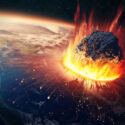While it might be nice to avoid any dangerous confrontations on your wilderness walks, life without wildlife would be pretty boring. If we didn’t have animals keeping Earth’s biodiversity balanced, we’d suffer major repercussions, and well, we might be the next species to kick the bucket.
Why do experts believe we are in the sixth great extinction? Could we all survive as vegetarians? How would the pharmaceutical industry be affected?
There have been five major extinctions throughout history and we may be on the cusp of a sixth. Generally, these extinctions are so significant that 75 to 90 percent of all species on Earth disappear. They can be traced back geologically through the chemical composition of rocks and fossils.
Over the last 11,500 years, we have been in the Holocene Epoch, a period which began at the end of the last Ice Age. But many scientists suggest that we are actually in the middle of the Anthropocene Epoch, a shift which is thought to have started at the onset of fossil fuels and the Industrial Revolution. Others suggest it began as soon as humans started farming.
Whatever the case is, as our population increases, the demand for food, fuel, and plastic production is growing rapidly, and our wildlife is diminishing. So what would life be like if we were the last species to go extinct?
A recent intergovernmental report estimates up to one million animal and plant species are on the brink of extinction. To put things into perspective, over 50 percent of modern medicines and 90 percent of traditional medicines derive from wild plants and animals.
And when it comes to testing important life-saving vaccines, animal trials are essential. Without them, we could shift into a post-apocalyptic world where humans would be used as lab rats. Rodents make up 75 percent of all animals in scientific testing. They are easy to breed and their physiology and genes overlap with humans.
Without our whiskered little helpers, we’d have to rely on computer modelling and in-vitro tissue culture design for our test results. This transition wouldn’t happen overnight and would be an expensive and logistical hurdle for many scientists.
Animals also provide life-saving ingredients, such as viper venom for blood pressure medication and insulin from the pancreases of pigs. And, of course, all our tasty animal products like milk, cheese, hamburgers and the like, would be a distant memory. We’d have to ramp up the production of lab-grown meat and vegetables to keep the population from starving.
There’s also plankton, which provide a huge portion of the planet’s oxygen and help regulate climate change. Without it, we’d have a tougher time breathing.
And let’s not forget our bee friends and other pollinators who help our vital plant life grow. We would have to innovate new technologies to pollinate artificially, such as insect drones and wind systems.
Also, I’m sorry to say, but any fancy silks, wool sweaters or cotton t-shirts you’re planning to buy are going to be much more expensive and in poor supply. In the absence of silkworms, sheep, and properly pollinated cotton crops, we’d have to endure a wardrobe full of synthetic clothes. Ugh, it’s so itchy.
As for our furry companions, we’d have to stick to robotic pets, which let’s be honest, just aren’t as cuddly. Gee, life would be so lonely without Truffles by my side.
The good news is, thanks to ongoing conservation efforts, whales are doing swimmingly and almost back to their pre-whaling numbers.The near-extinct bald eagle population is also now recovering. And against all odds, the gorillas of Virunga National Park continue to thrive, because people are committed to saving them. But there is still much work to be done to keep our animal population healthy.
Sources
- “Wait, Have We Really Wiped Out 60 Percent Of Animals?”. Yong, Ed. 2018. The Atlantic.
- “What Is The Anthropocene?”. 2021. nhm.ac.uk.
- “What we lose when animals go extinct”. 2021. Animals.
- “How Saving Wildlife Benefits Humans – In Ways We Really Need”. Marina, Quatab. 2020. One Green Planet.
- “What are mass extinctions, and what causes them?”. MICHAEL GRESHKO 2021. Science.


























